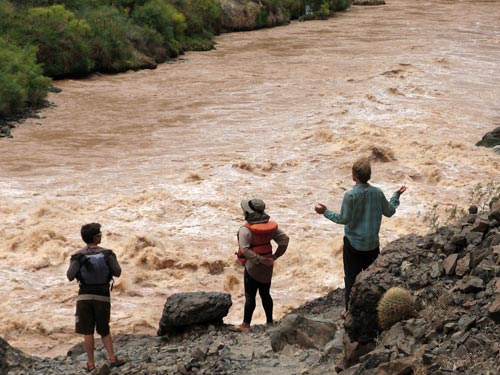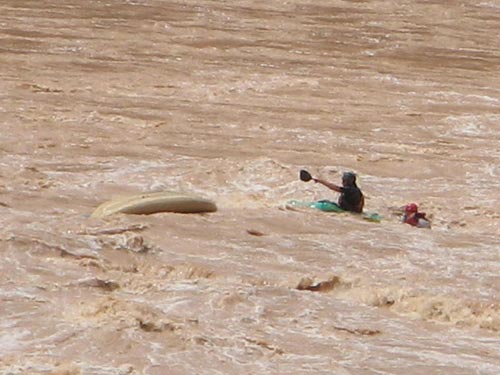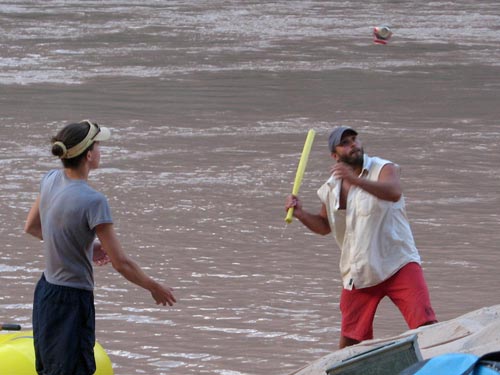Today was a big day... we were going to run Lava Falls, one of the most dangerous rapids.

The view from the tent at Fern Glen campsite

An orange Paper Wasp begins its day. Paper wasps gather fibers from dead wood and plant stems, which they mix with saliva and use to construct water-resistant nests. The nests are a grey or brown papery material.

A cicada has transparent wings.
There are about 2,500 species of cicada around the world. They don't bite or sting but are often considered a pest to some cultivated crops. Many people regularly eat them (the female is better because it's meatier). The name cicada comes from Latin meaning 'buzzer.' Only the males sing, but not by rubbing their wings or legs together like other insects such as crickets. Instead they have structures called timbals on the sides of their lower bodies. Timbals are regions of the exoskeleton that are modified to form a complex membrane. Contracting muscles produce a clicking sound as the timbals buckle inwards and another click as the muscles relax and the timbals return to their original position. The interior of the male abdomen is basically hollow to amplify the sound. They modulate their noise by wiggling their abdomens toward and away from the tree that they are on. Each species has its own distinctive song. When thousands of cicadas sing from the trees, the sound can be almost deafening.

Discarded cicada skin. Cicadas live underground (between 1 - 8 feet deep) as nymphs for most of their lives. The nymphs feed on root juice and have strong front legs for digging. Eventually they tunnel to the surface and emerge. They then shed their skins (molt) and emerge as winged adults.
The Grand Canyon was not just carved by water, it has also been the scene of periodic wars between the Colorado River and volcanic eruptions. The Uinkaret Volcanic Field covers about 200 square miles, extending about 50 miles north from the Colorado River. The volcanic features (basaltic cinder cones and lava flows) lie within the canyon and on the plateaus to the north. In the last 2 million years, more than 150 lava flows have poured into the Grand Canyon. These flows formed 13 major lava dams that ranged in height from 200 - 2,000 feet. The largest one created a lake that extended all the way back to Lee's Ferry. Over the last 725,000 years, there have been at least four lava flows that dammed the river. These dams were either breached by dramatic floods or simply eroded away as the river flowed over their tops.

Here is a computer rendering of the Uinkaret Volcanic Field when it was active.

Black volcanic rock begins to appear in the canyon.

Vulcan's Anvil at mile 178
Vulcan's Anvil is all that remains of the core of an ancient volcano that erupted right up through the bed of the river. The softer rock that made up the volcano itself has long since been eroded away.

A look back at Vulcan's Anvil
Lava Falls Rapid (an 8-10 on the scale) at mile 179.2 is one of the most treacherous rapids in the canyon, having a drop of 13 feet in only about a quarter mile passage. Several large deposits of volcanic rock partially block the river, forming two massive holes. Proper entry is everything. Almost nothing you do after you enter the rapid will matter one bit until you are in the tailwaves.

Pulling ashore to scout the rapid

Everyone studies the rapid diligently.


Here are some of the lava formations that give the rapid its name.

The kayakers navigate the rapid...

... until one of them gets flipped!

The rafts begin to enter the rapid.
Even though the river is very deep and you would be unlikely to hit your head on a submerged rock, helmets are a good idea on the bigger rapids since a flip could still bring the heavy raft (or oars, ammo cans, etc.) down on top of you.

Heading into the thick of it.

Whew! A bit of relaxation after a tough run. Everyone made it without flipping!
Lava formations were now predominant along the cliff walls.





Basalt columns


An old volcanic core...

... a direct view

The remains of a giant lava flow
We passed by Whitmore Wash. This is a very popular tourist destination, including via helicopter flights.

The petroglyphs (albeit a bit hard to see) at Whitmore Wash include handprints, strange figures and sun symbols.
We finished the day at 194 Camp.

Lunch on the beach

The game is on!


Dinner... including dessert!
return • continue

